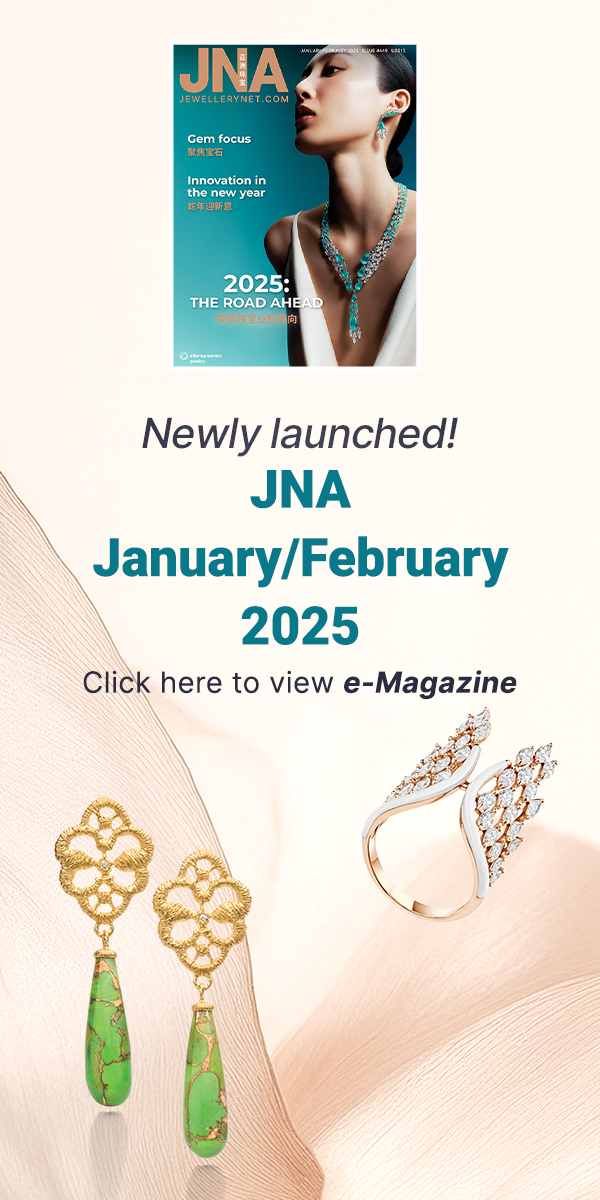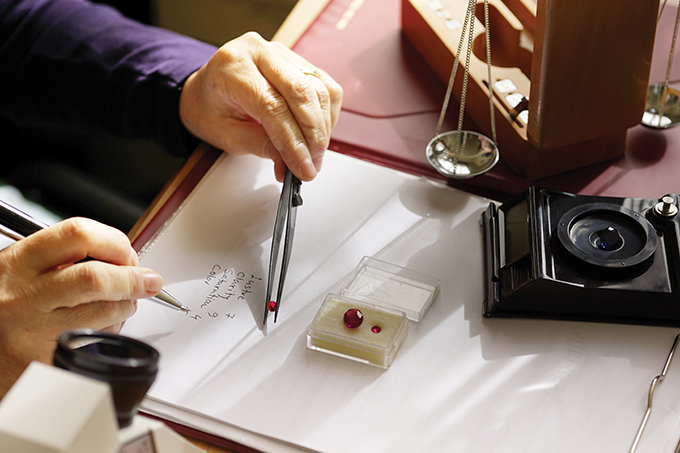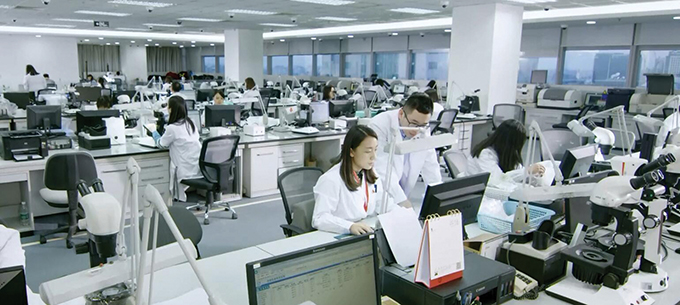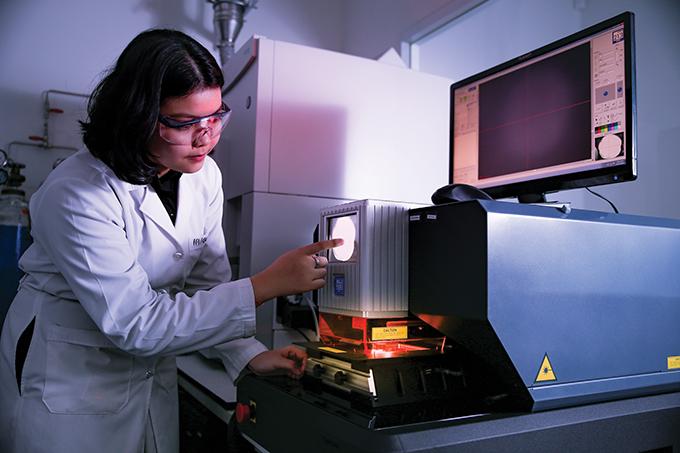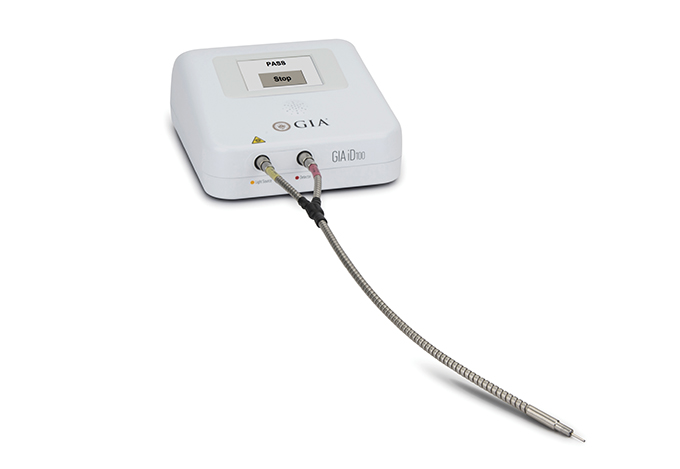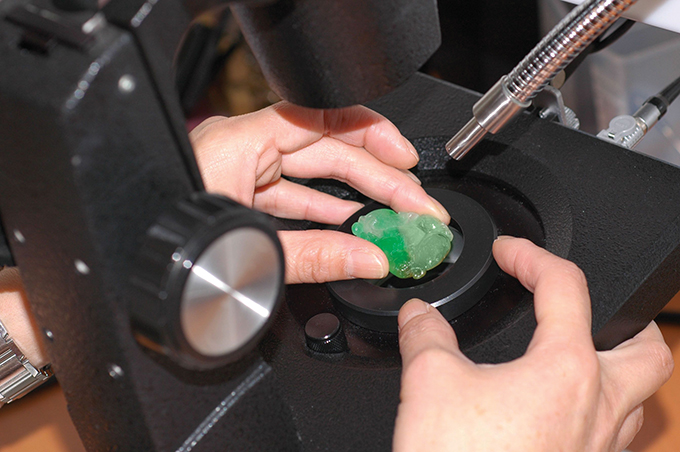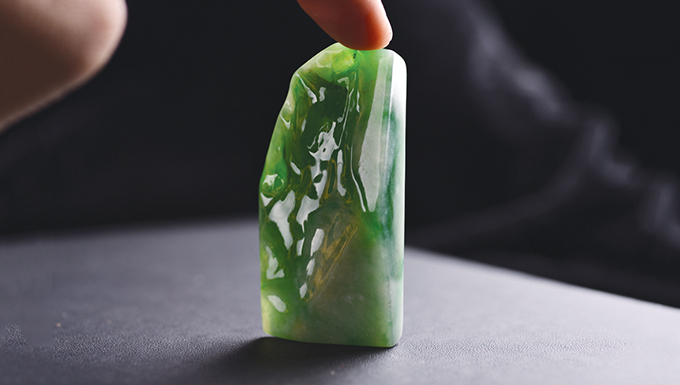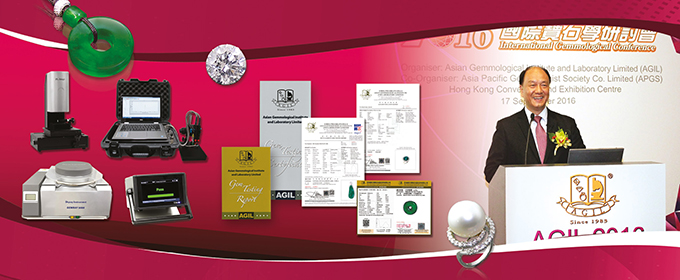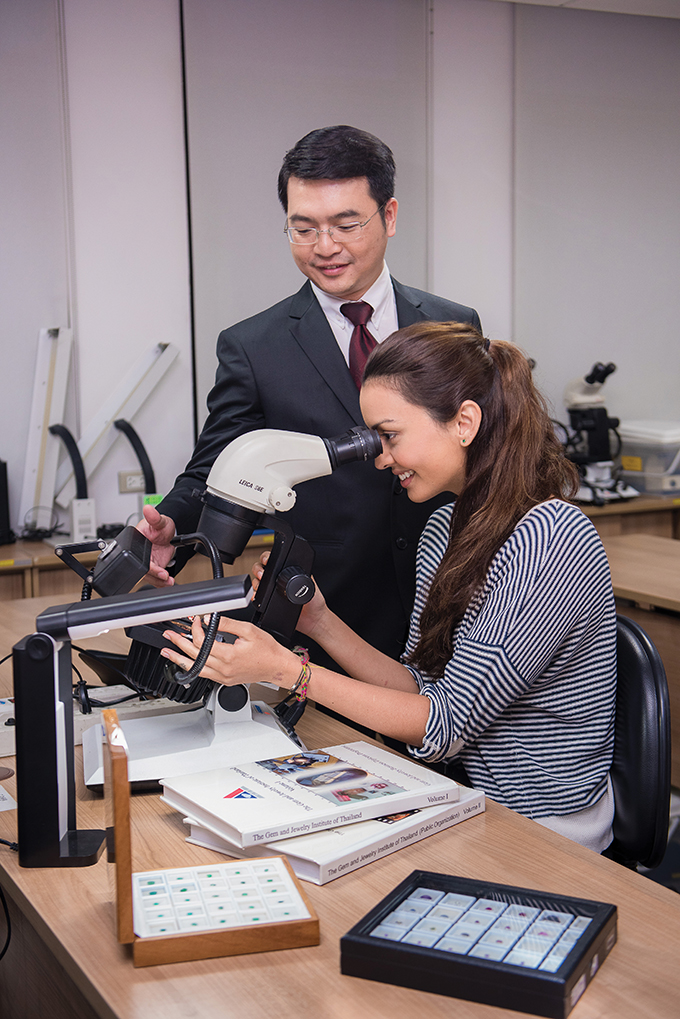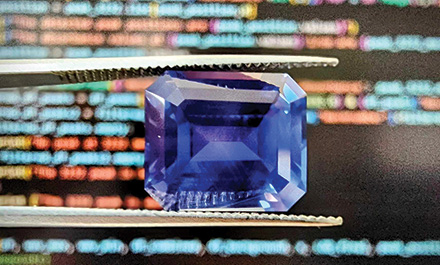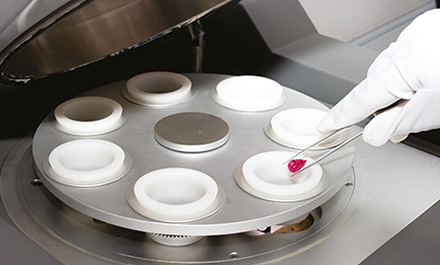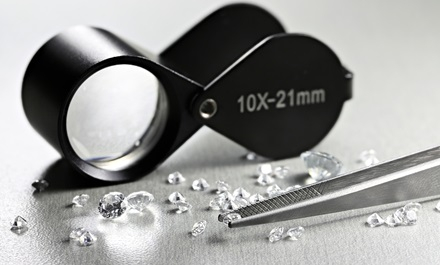With modern consumers’ incessant call for transparency, traceability and responsible sourcing, gemmological laboratories are revolutionising testing methods and upgrading facilities to meet the demands of discerning consumers. This special report highlights gem labs’ increasingly critical position in fostering consumer confidence in the gemstone trade.
Amid a tougher business environment, gemmological laboratories remain a galvanising factor in safeguarding integrity in the gemstone and jewellery trade. With technology as their ally, gem labs rely heavily on research and innovation to identify ever more sophisticated gemstone treatments and new types of synthetics or simulants.
Jonathan Kendall, president of the International Institute of Diamond Grading & Research (IIDGR) of the De Beers Group, highlighted the indispensable part that technology plays in the diamond sector.
“We are in a constant battle to keep steps ahead,” noted Kendall. “As the technology to create laboratory-grown diamonds improves, so must we to offer the industry new and robust instruments.”
The De Beers Group, one of the biggest players in the global industry, is doing non-stop research into lab-made diamonds. The process involves analysing materials produced for its own research as well as externally purchased samples.
IIDGR works alongside Element 6, another De Beers facility, on lab-grown diamond research and development, giving the lab a unique position in the field to provide high-tech solutions to the industry.
“It is vital that gem labs are used throughout the industry to verify and grade diamonds to the highest levels,” revealed Kendall. “As consumers become more informed, they will demand more information and clarification that their purchases have gone through the correct channels.”
In the area of coloured gemstones, “verifiable and auditable chain-of-custody” by an independent third party is gradually becoming a requisite by “critical consumers,” said Dr. Daniel Nyfeler, managing director of Gübelin Gem Lab.
Gübelin’s answer to this is its Provenance Proof Initiative, which features state-of-the-art gem paternity tests and the use of blockchain technology.
Consistent and accurate treatment detection remains a challenge in the gemstone sector, shared Nyfeler. In rubies for instance, he cited a kind of low-temperature heat treatment that is applied to improve the colour of the stone while remaining “under the radar of what gem testing labs can detect.”
According to the company official, this has led to a steady lowering of the threshold of what gem labs consider as treatment in emeralds, adding that the undisclosed filling of fissures after gem-lab testing is a huge threat to consumer confidence.
These instances highlight the responsibility of gem labs to protect consumer trust.
“Gem labs continue to play an important role as a neutral entity between the buyer and the seller by disclosing the value-driving parameters such as identity, authenticity, treatment and origin of a stone,” stressed Nyfeler.
Pearl testing also counts on technological advancements to deliver accurate and reliable results, according to Bahrain Institute for Pearls & Gemstones (Danat) CEO Kenneth Scarratt.
The latest in the science of pearl testing and identification include combining high-tech methods such as DNA, isotope analysis and laser ablation–inductively coupled plasma-mass spectrometry or LA-ICP-MS on samples from known origins (molluscs, for instance) to get a clearer image of samples. A recent important development is the use of spectroscopy to identify host molluscs, which is particularly interesting for coloured (nacreous) natural pearls, noted Scarratt.
Currently, detecting saltwater cultured pearls with atypical beads such as low-quality natural pearls poses a challenge for gemmological laboratories.
The presence of such pearls in global markets could threaten the natural pearl sector thus raising the need for all potential natural pearls to be examined and a third-party verification be obtained before any purchase, the company official revealed. Majority of laboratories that specialise in pearls are equipped with the latest x-ray imaging techniques to identify these pearls, he added.
“The role of gemmological laboratories is vital in this industry’s cycle. For loose stone and pearl wholesalers, jewellery manufacturers and end consumers, authentication and verification of items is an important factor,” said Scarratt. “A report from a reputable lab adds value to the market, safeguarding the reputation of the seller and the interest of the buyer. It is the responsibility of any operating lab to generate honest and transparent reports as well as educate the trade and the general public.”
China's National Gemstone Testing Center (NGTC), for its part, highlighted the need to invest in scientific research to ensure reliable results. For instance, NGTC produced its own GV-5000 melee screener to effectively detect synthetic melee diamonds.
With China as the world’s largest producer of synthetic diamonds, NGTC also initiated the drafting of industry guidelines to standardise their definition, identification and classification.
NGTC also attaches great importance to the education of consumers. In partnership with various industry stakeholders, the centre established an online platform to promote gemmological knowledge, jadeite culture, sustainable consumption and the importance of identification reports.
The platform has received more than 20 million clicks, and reached approximately 200 million consumers from the capital region (Beijing, Tianjin and Hebei), Shanghai and adjacent regions, as well as Chongqing, Sichuan, Yunnan and Guizhou of southwest China.
“Looking ahead to 2019, the platform aims to reach consumers from Liaoning, Jilin and Heilongjiang of northeast China, and continue to enhance the public’s trust and confidence in NGTC,” the centre said.
ICA | Gemlab: The millennial evolution
Established in 2016, the ICA | Gemlab operates in accordance with ethical standards set by the International Colored Gemstone Association or ICA. The lab is aimed at fostering confidence in the coloured gemstone trade through advanced technology and top-of-the-line gemmological education.
Omar Wahid Hatta, director of ICA | GemLab, talks about the lab’s unique market position and its vision to modernise gemstone valuation methods.
What is the lab’s vision mission?
Omar Wahid Hatta: The gemstone trade has adhered to time-honoured methods for many years. Other industries however have started adopting technological advancements and digitalisation while the gem trade remained stagnant.
If we take a closer look at the diamond industry and its fast pace of modernisation, it becomes more clear that the gem sector has yet to achieve the same level of growth and standards as the diamond trade.
ICA | GemLab believes that the coloured gem industry deserves an equal amount of attention and reverence. We are committed to upholding ICA’s values as we step into the future and revolutionise the way a gemmological laboratory is viewed. Digitalisation and accessible education will be our first step.
The gem and jewellery industry is facing fundamental changes in the market brought about by more discerning consumers as well as stronger calls for transparency. What is your role in such a situation?
Hatta: Moving beyond the definition of a traditional gemmological laboratory, the ICA | GemLab aims to utilise its resources to provide completely transparent gemmological knowledge. Transparency will be the soul and backbone of our laboratory. To better educate millennials and the next generation of consumers, we will introduce changes to traditional trading techniques and methods of gemstone valuation by maximising the use of technology.
Our main focus at ICA | GemLab are coloured gemstones. Apart from providing testing and verification services, we also place a premium on gemmological education.
Do you foresee any challenges in gem testing and if so, how do you plan to address these?
Hatta: The gemmological industry is yet to reach its peak. Evolution is the key to ensuring the growth of the coloured gemstone sector. To do this effectively, we need to reignite the market’s interest in gemstones and provide the trade with relevant gemmological knowledge. In this light, we are taking it upon ourselves to educate millennials and inspire them to value coloured gemstones through a more modern perspective. Again, we want to capitalise on the powers of digitalisation to make gemmoligical education and expertise accessible and more interesting to the younger generation.
GIA reinforces gemmological expertise and leadership
The Gemological Institute of America (GIA) continues to make inroads in research-based gemmological identification and grading services. In 2018, it expanded its laboratory facilities in Hong Kong and Surat to meet more sophisticated consumer demands. It also plans to offer more services at its Antwerp facility. GIA’s Tom Moses speaks about the lab’s strong commitment to provide timely, quality laboratory services to ensure consumer protection.
What are the latest developments in the lab-grown diamond sector? What is GIA doing to face new challenges on this front?
Tom Moses: In July 2018, the US Federal Trade Commission expanded its definition of diamonds to include both mined and laboratory-grown stones. While this is a potentially significant development, it is important that the origin of diamonds, coloured gemstones and pearls be disclosed fully so that the consumer is clear about what he is purchasing. The expert and advanced instrumentation at GIA’s laboratories can definitively identify both CVD and HPHT laboratory-grown diamonds. The GIA iD100 screening device and the GIA Melee Analysis Service offer manufacturers and retailers efficient and reliable options for confirming the characteristics of their diamonds.
What is the market response to your M2M programme?
Moses: Dozens of retailers and several manufacturers are signed up, and we continue to engage other diamond producers as part of the initiative. In 2019, we will focus on GIA’s ability to scientifically match diamond rough that we have examined to the resulting polished gems. GIA has processed thousands of rough diamonds ranging from one carat up to more than 100 carats.
Are you considering more partnerships with retailers on the use of blockchain technology to deliver modernised, highly secure diamond grading reports?
Moses: The blockchain technology can have a broader application to how GIA and its clients manage diamond grading and other reports. We plan to explore expansion of blockchain technology to further enhance consumer trust and experience with GIA reports.
Any updates on gemmological education/courses offered by GIA? Which course programmes are most sought after by students?
Moses: As a leader in gemstone analysis and grading, and field gemmology research, GIA is uniquely positioned to provide our students with the most up-to-date knowledge and skills. Our jewellery design programmes and courses teach students the skills to become jewellery designers, including hand-rendering and computer-aided design. The GIA Graduate Gemologist® diploma is one of the world’s most sought-after and recognised credentials in the gem and jewellery industry. This credential provides a comprehensive education in the world of diamonds and coloured gemstones. Students can also enrol in short-term lab classes on diamonds and coloured gemstones to improve grading and identification skills or to help complete a credential through the GIA Distance Education Program.
How critical are gemstone-testing services in today’s rapidly growing jewellery and gemstone market?
Moses: Independent, unbiased research-based gemstone identification and grading services are absolutely vital to protecting consumers and giving them added confidence in their purchases. Without consumer confidence, the trade would face significant consequences. The more than 3,000 dedicated staff of GIA work every day to help ensure consumers’ trust in gems and jewellery – that is our mission.
HKJSL takes the lead in Fei Cui testing
Established in 1993, the Hong Kong Jade & Stone Laboratory (HKJSL) strives to maintain Hong Kong’s position as an international jade trading centre while safeguarding consumer and trade interest. HKJSL enjoys a stellar reputation in the gemstone trade, thanks to its advanced Fei Cui-testing services. Joanne Chan, HKJSL’s chief gemmologist, highlights the company’s indelible role in the natural Fei Cui industry.
Please share with us your lab’s vision mission.
Joanne Chan: HKJSL provides professional, fair, objective and accurate identification services for the trade and the public through its cutting-edge facilities. As an accredited laboratory of the Hong Kong Laboratory Accreditation Scheme or HOKLAS since 2004, HKJSL is committed to providing Fei Cui testing services with the highest standards of reliability, consistency and integrity.
How are you responding to the market’s ever-changing needs?
Chan: We keep pace with the times by equipping our lab with the most advanced testing devices while providing the staff with top professional training. In a bid to avoid disputes in the trade over divergent terminologies, HKJSL employs a definition of Fei Cui that conforms to descriptions under the Trade Descriptions Ordinance of the Customs and Excise Department of Hong Kong.
What are the challenges in Fei Cui testing today?
Chan: The Fei Cui testing and identification industry is currently facing the challenge of a declining jewellery retail sector as well as competition from the growing number of local and overseas laboratories in the city.
How can scientific analysis and standardised testing systems benefit the trade and consumers?
Chan: Scientific analysis and a standardised testing system provide trade practitioners with an impartial and open trading environment; enhance transparency in the supply chain of Fei Cui; consolidate the position of Hong Kong as the world’s Fei Cui trading hub; boost consumer confidence in buying Fei Cui products; and strengthen consumers’ accurate understanding of Fei Cui, hence stimulating further demand for the gemstone.
AGIL boosts industry competence with advanced technology
Recognised as the oldest gemmological laboratory in Hong Kong, the Asian Gemmological Institute and Laboratory Ltd (AGIL) employs cutting-edge technology to provide comprehensive and professional gemstone testing and identification services. Dominic Mok, principal of AGIL, shares his passion for excellence by constantly upgrading and innovating lab equipment and identification processes. To keep the industry abreast with the latest trends and developments, AGIL also holds regular lectures and seminars.
What are AGIL’s competitive advantages?
Dominic Mok: AGIL is the first gemmological laboratory accredited by the Hong Kong government. Our state-of-the-art instruments include the Gemray 5000 energy dispersive X-ray fluorescence spectrometer – the first of its kind in Hong Kong – which further upgraded our ability to identify a gemstone’s composition for locality check. AGIL is also equipped with Toptek Dual Source Raman Spectrometer, an EXA™ natural diamond screener, a photoluminescence imaging system, and a GLIS-3000 gem luminescence imaging system to help identify natural and synthetic diamonds.
What are the latest trends in gem identification as well as challenges faced by gemmological laboratories?
Mok: Take the identification of Fei Cui (jadeite jade) for example. In the past, clients only cared about the authenticity of a gemstone. However, with information becoming highly accessible, gemstone traders and buyers have become more educated and sophisticated; they want to know specific and detailed information such as the type of Fei Cui. When it comes to diamonds, synthetic stones are becoming more mainstream and posing new challenges to gemmological laboratories. Simulants that imitate synthetic diamonds are already in the market, which means our job is no longer just to differentiate between natural and synthetic diamonds. We are now equipped with the necessary instruments to identify different kinds of synthetic diamonds.
How do AGIL’s gemmological programmes and seminars benefit the industry?
Mok: We stand at the forefront of the gem and jewellery industry, serving the trade as well as consumers and collectors of gemstones. We also consider it our mission to promote gemmological knowledge in general by holding international seminars and providing training programmes. Participants in our seminars and programmes can find out the latest developments in gem identification and gemmology, and deepen their knowledge of particular gemstones. We aim to help everyone in the industry improve their expertise through continuing education.
GIT rises at the helm of coloured gem-testing
The Gem and Jewelry Institute of Thailand (Public Organization) or GIT remains at the forefront of gemmological proficiency through continued international collaborations to promote research and innovation. Duangkamol Jiambutr, director of GIT, discusses the organisation’s business strategies and direction moving forward.
How would you describe 2018 for GIT? What were the highlights of your operations?
Duangkamol Jiambutr: GIT constantly supports Thailand’s gem and jewellery industry through reliable gemmological services and identification reports. Thanks to its expertise and competence, GIT holds internationally recognised CIBJO and Laboratory Manual Harmonisation Committee accreditations; and several certifications from the International Organization for Standardization or ISO such as ISO 17025.
GIT also implemented a sustainable revenue-generating project in regional areas to strengthen communities and promote gem and jewellery businesses. We also provide design and business courses and help display participants’ products at the TEMP Pop-Up Store by GIT, a channel aimed at expanding the global reach of Thai products.
GIT is also helping to build Chanthaburi province’s image as a “gem metropolis” by organising the International Chanthaburi Gems and Jewelry Festival 2019, which will feature rough gemstone displays, ready-to-wear jewellery sets, manufacturing innovations, and machinery and packaging tools.
GIT earlier signed an agreement with China’s National Gemstone Testing Center (NGTC). Any update on this?
Jiambutr: GIT and NGTC are establishing identification standards for coloured gemstones to help importers and exporters trade goods with confidence. The initiative will be carried out through GIT identification reports. Both organisations will collaborate in publicising standards for pigeon’s blood rubies, and royal blue and cornflower blue sapphires.
How about your collaboration with the Mozambique government?
Jiambutr: GIT is revising a memorandum of understanding (MoU) between Thailand and Mozambique that allows stronger collaboration on research and human resource development. The MoU stipulated cooperation on research; raw material exploration; gemstone identification, cutting and polishing, and identification reports; technical support; and training, among others.
GIT helped host the World Ruby Forum in 2017. What did the forum achieve?
Jiambutr: The World Ruby Forum in conjunction with the CIBJO Congress 2017 is one of GIT’s most successful projects. The event drew international recognition to the Thai gem industry. More than 400 traders from around the world attended the World Ruby Forum.
This year, Thailand will host the ICA Congress 2019 on October 12 to 15 and we are working closely with the Thai Gem and Jewelry Traders Association and the private sector on this front.
What is the latest in coloured gemstone testing technology?
Jiambutr: In the ruby and sapphire business, low-temperature heating, which is difficult to detect; as well as oil and resin filling became hot topics. A new low-pressure heating technique for sapphires is another issue. GIT, and other international trade organisations, is conducting technical meetings and sharing research findings to come up with a universal testing technique to identify such treatments. Also part of the discussions is how to properly disclose such treatments and the terminologies to be used to ensure consumer protection.
What is your growth strategy in 2019 and beyond?
Jiambutr: In line with the government’s policy, GIT’s vision is to propel Thailand to become the world’s gem and jewellery trading hub by 2021.
From 2019 onwards, GIT will upgrade its gemstone, precious metal and jewellery identification standards to international levels by using globally recognised references; promote research, development and innovation to enhance production, marketing and competitiveness in the trade as well as publicise research findings domestically and internationally; promote staff training; and develop knowledge networks to improve information dissemination and exchange in the gemstone sector.


